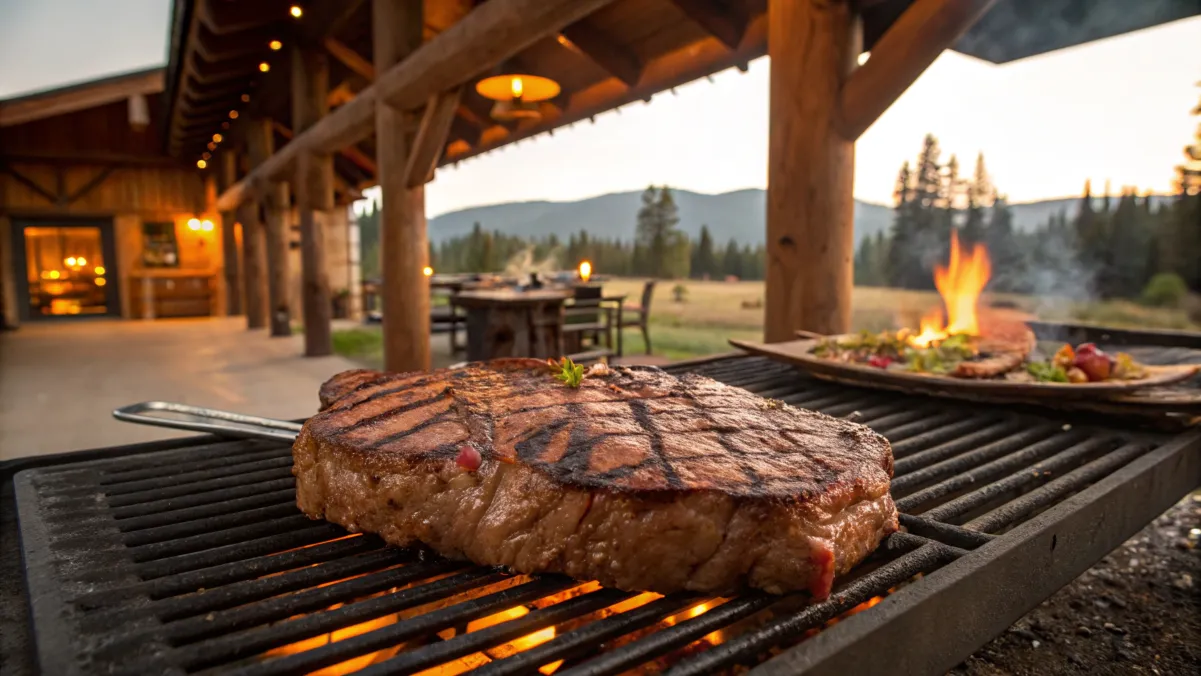Written by Sarah Miller
The sizzle of a cowboy steak on a hot grill brings back summer evenings at my family’s ranch in Wyoming. Those moments taught me that a great high-quality beef experience is more than food. It’s about tradition, passion, and connection.
The cowboy ribeye is more than a meal; it’s a culinary adventure. This bone-in steak embodies American grilling culture. It promises a taste experience that connects us to generations of cooking.
Whether you’re a seasoned grill master or a curious home cook, making a perfect cowboy steak is an art. It combines technique, quality ingredients, and a deep respect for beef craftsmanship. Get ready to elevate your cooking skills and tantalize your taste buds with the ultimate steak experience.
Understanding the Cowboy Steak: A Premium Cut
The cowboy steak is a top choice for beef lovers. It’s a big, bone-in ribeye cut that’s full of flavor. This steak is loved for its taste and how it looks, making it a favorite among foodies.
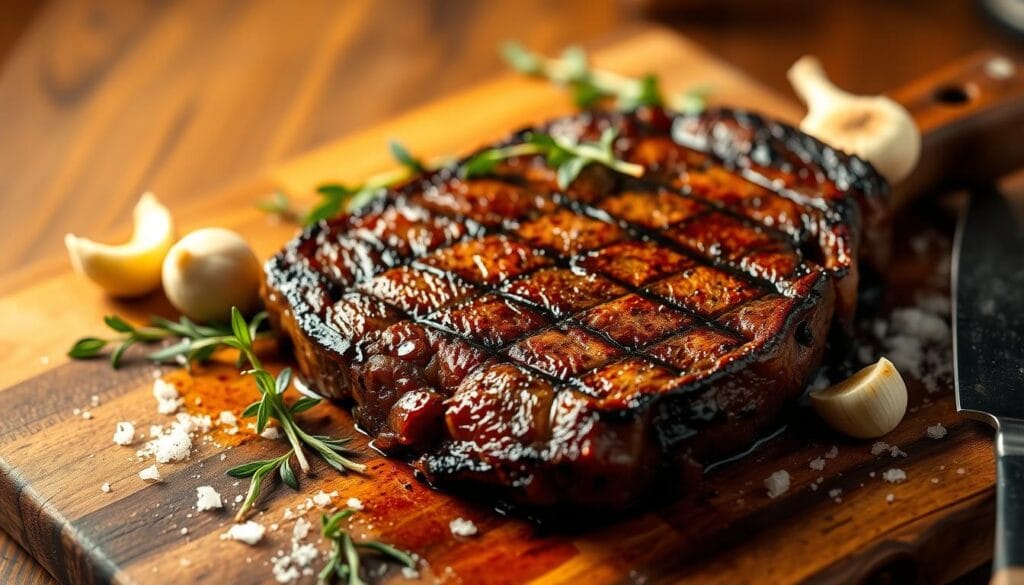
Anatomy of a Perfect Cowboy Cut
A cowboy steak is usually 2 inches thick. It’s cut from the rib section, known for being tender and juicy. Compared to other steaks, the cowboy steak is the best for those who love strong flavors.
- Thickness: 2 inches
- Bone-in presentation
- Sourced from rib primal section
- Weight range: 1.25 – 3.74 lbs
USDA Grading and Quality Standards
Knowing about USDA beef grades is key to picking a great cowboy steak. The grades look at marbling, maturity, and muscle development.
| USDA Grade | Marbling Level | Flavor Intensity |
|---|---|---|
| Prime | Abundant | Exceptional |
| Choice | Moderate | Very Good |
| Select | Minimal | Good |
Marbling Characteristics
Marbling in steaks means the fat inside the meat. It makes the steak taste amazing and feel tender. The cowboy steak has lots of marbling, making it special compared to other steaks.
“The cowboy steak isn’t just a meal—it’s a culinary adventure that celebrates the art of beef preparation.” – Professional Chef
Choosing a top-notch cowboy steak means knowing about these special features. It promises a memorable meal that shows off the skill of beef making.
The Rich Heritage Behind Cowboy-Style Cooking
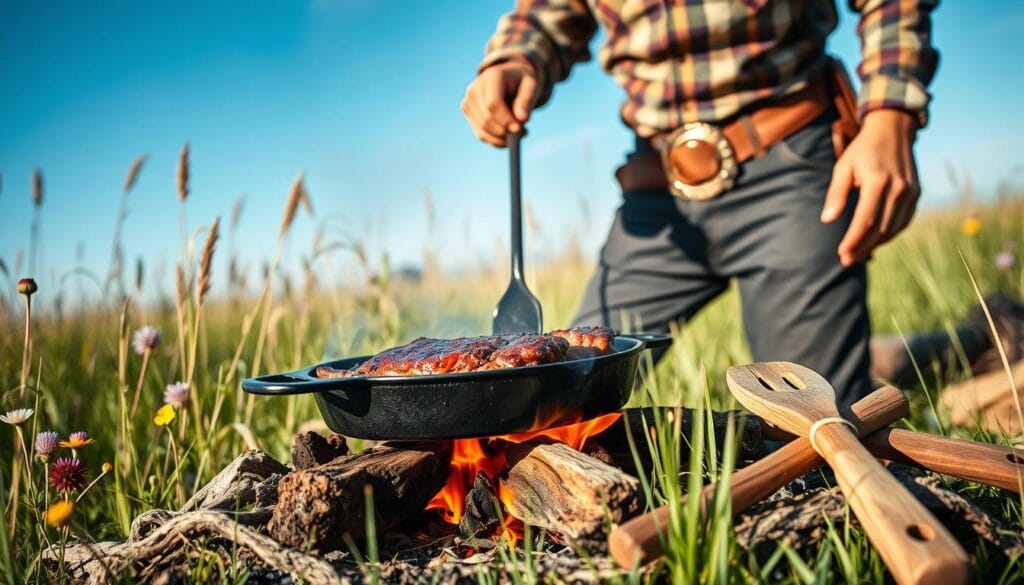
The roots of cowboy-style cooking are deep in the American West. It was shaped by survival and the need for good food. Outdoor grilling became a way of life for those working with cattle. They made simple ingredients into hearty meals.
“A good cook could make a feast out of nearly nothing, and that was the true art of cowboy cuisine.” – Ranch Folklore
The chuckwagon, introduced in 1866 by Charles Goodnight, changed how bbq cowboy steak was made. It was a mobile kitchen for cowboys on long drives. They used cast iron skillets and Dutch ovens to cook in tough conditions.
- Typical chuckwagon ingredients included:
- Dried beef and fresh beef cuts
- Beans and cornbread
- Coffee
- Simple spices like salt, black pepper, and cumin
Cowboys found creative ways to cook with limited resources. Beef jerky was a key protein source. Stews and bean dishes gave them the nutrition they needed for long days.
| Cultural Influences | Contribution to Cowboy Cuisine |
|---|---|
| Spanish Vaqueros | Cattle ranching techniques |
| Native American Tribes | Tracking and hunting methods |
| Mexican Traditions | Cooking techniques and culinary vocabulary |
Today, cowboy-style cooking is all about simplicity and quality. It uses old cooking methods to honor the American West’s culinary heritage.
Essential Tools and Equipment for Perfect Preparation
Getting the perfect bbq cowboy steak needs more than just great meat. The right tools can make a big difference. Professional chefs know that using the right equipment is key for grilling ribeye or making cast-iron skillet steaks.
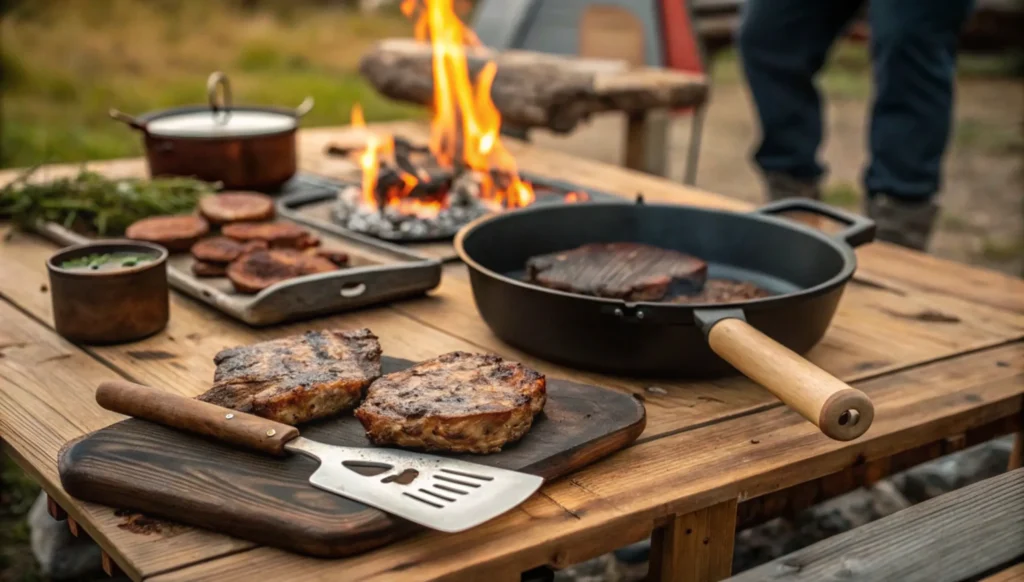
Choosing the right equipment is key for cooking like a pro at home. Your kitchen should have a few important tools to make sure your steak is perfect every time.
Cooking Surface Selection
Chefs often debate between cast-iron skillets and traditional grills. Each has its own benefits:
- Cast-iron skillet: Keeps heat well and cooks evenly
- Grill: Gives smoky flavor and nice char marks
- Hybrid approach: Sear in cast-iron, finish on grill for more flavors
Temperature Monitoring Tools
Getting the temperature right is what sets pros apart from beginners. You’ll need reliable tools for this:
- Instant-read digital thermometer: Shows meat’s internal temperature
- Wireless meat thermometer: Lets you check from a distance
- Infrared surface thermometer: Checks the grill’s heat
Essential Cutting Implements
A sharp knife is your best friend for preparing and serving bbq cowboy steak. Look for:
- Sharp chef’s knife: For precise cuts
- Boning knife: For removing fat
- Carving knife: For clean slices
“The right tool transforms good cooking into great cuisine.” – Professional Chef
Getting these essential tools will greatly improve your steak-making skills. You’ll get consistently tasty results with your cast-iron skillet steaks and grilling ribeye.
Selecting and Storing Your Premium Cut
Choosing the perfect cowboy steak is a big deal. It starts with knowing about USDA beef grades and picking the best cuts.
Identifying Top-Quality Cuts
When looking for the ultimate cowboy steak, keep these tips in mind:
- Choose USDA Prime or Choice grades
- Check the marbling patterns
- Look for a bright red color
- Make sure it’s at least 2 inches thick
Weight and Pricing Considerations
The best cowboy steak has a weight that balances flavor and cost. On average, it costs $36.74. Here are some weight ranges to consider:
- 1.75 – 1.99 lbs
- 2.00 – 2.24 lbs
- 2.50 – 2.74 lbs
- 3.00 – 3.24 lbs
Storage Techniques
Proper storage is key to keeping the steak’s quality and flavor. Keep it in the coldest part of the fridge. Follow these steps:
- Store for 3-5 days max
- Wrap it tightly in plastic wrap
- Freeze for up to 6 months if you need to
“The secret to an incredible steak starts with selecting and storing it with precision.” – Culinary Expert
For those who love top-notch beef, Black Angus from 44 Farms is a great choice. They raise their cattle without growth hormones or antibiotics, following strict NE3 standards.
Master the Art of Cooking a Thick-Cut Ribeye
Seasoning turns a simple steak into a memorable dish. For those who love bbq cowboy steak, learning to season is key. It makes your steak grilling recipes stand out.
Traditional Rubs and Marinades
Creating a top steak grilling recipe starts with the right seasonings. Cowboy-style rubs often include:
- Coarse kosher salt
- Freshly ground black pepper
- Garlic powder
- Smoked paprika
- Dried herbs like oregano
The Role of Salt and Timing
Salt is vital in searing techniques. Chefs suggest two salting methods:
- Early salting: Salt the meat 40 minutes before cooking to tenderize it
- Late salting: Sprinkle salt right before grilling for a strong crust
Signature Cowboy Butter Recipe
Cowboy butter makes your bbq cowboy steak even better. Here’s a simple recipe:
| Ingredient | Quantity |
|---|---|
| Unsalted butter | 1/2 cup |
| Fresh parsley | 2 tbsp, chopped |
| Minced garlic | 2 cloves |
| Lemon juice | 1 tbsp |
| Dijon mustard | 1 tsp |
“Great seasoning is the secret weapon of every legendary cowboy chef.”
Mix the ingredients, chill, and spread on your grilled steak. It’s a true cowboy culinary delight.
Cooking the Perfect Grilled Cowboy Steak: Tips and Techniques
Mastering searing techniques is key to making an amazing cowboy steak. It’s about getting a perfect crust and keeping the inside juicy. This needs precision and knowing how to manage heat.
Professional chefs say there are two main ways to grill ribeye: the two-zone fire method and using a cast-iron skillet. Each way has its own benefits for getting that golden-brown crust.
- Two-Zone Fire Grilling
- Create separate high and low-heat areas on the grill
- Sear steak for 2-3 minutes per side over direct heat
- Move to indirect heat to finish cooking
- Cast-Iron Skillet Method
- Preheat skillet until smoking hot
- Add high-smoke-point oil
- Sear steak for 3-4 minutes per side
- Finish in preheated oven at 425°F
“The secret to a perfect steak is understanding heat control and timing.” – Professional Chef
Reaching the right temperatures is vital for searing. Start with an internal temperature of 115°F before searing. Then, aim for 450-500°F to get that amazing crust. A good meat thermometer, like the MEATER Pro, helps with precision.
Basting with butter during cooking can add flavor and improve the crust. Letting the steak rest after cooking helps the juices spread evenly. This makes the steak tender and juicy.
Temperature Guide for Various Doneness Levels
Learning about cooking temperatures for steak is key to becoming a great chef. The secret to a perfect grilled ribeye is knowing the internal meat temperatures. These temperatures affect the steak’s flavor and texture.
- 33% prefer rare
- 22% choose medium-rare
- 11% select each of medium, medium-plus, and black and blue
Internal Temperature Chart for Best Steak Cuts
When grilling ribeye or other top cuts, controlling temperature is vital. Here’s a detailed guide for doneness:
| Doneness Level | Temperature Range | Characteristics |
|---|---|---|
| Rare | 120-130°F | Cool red center, soft texture |
| Medium-Rare | 130-135°F | Warm red center, most popular among chefs |
| Medium | 135-145°F | Pink center with slight firmness |
| Medium-Well | 145-150°F | Slight pink center, firmer texture |
| Well-Done | 150°F and above | No pink, fully cooked through |
Resting Period: The Secret to Juicy Steaks
Resting is essential for a perfect steak. Remove the steak from heat 5-10°F below your target temperature. This step allows the steak to cook a bit more while juices spread out. This makes the steak tender and full of flavor.
“The difference between a good steak and a great steak is often just 10 degrees and five minutes of patience.” – Professional Chef
For top cuts like cowboy ribeye, let the meat rest 5-10 minutes before serving. This simple step turns an ordinary grilled ribeye into a top-notch meal.
Pairing Suggestions and Side Dishes
Choosing the right side dishes can make your high-quality beef meal unforgettable. The perfect steak cut is just the start. It’s the pairings that turn it into a true culinary journey.
When picking sides for your steak, aim for a balanced plate. You want to highlight the meat’s rich flavors, not hide them. The goal is to add to the experience, not take over.
Classic Side Dish Recommendations
- Grilled Vegetables
- Asparagus with garlic butter
- Roasted bell peppers
- Charred zucchini with herbs
- Potato Perfection
- Creamy mashed potatoes
- Rosemary roasted potato wedges
- Crispy smashed potatoes
Wine and Beverage Pairings
| Wine Type | Flavor Profile | Best Pairing |
|---|---|---|
| Cabernet Sauvignon | Bold and tannic | Ribeye and strip steaks |
| Malbec | Robust and fruity | Fatty, marbled cuts |
| Pinot Noir | Light and elegant | Leaner steak cuts |
Signature Cowboy Butter Enhancement
Pro tip: Top your steak with homemade cowboy butter for a burst of flavor. Mix garlic, herbs, and lemon for a taste that makes simple sides shine.
“A great side dish should complement, not compete with, a perfect steak.” – Culinary Wisdom
Most side dishes take just 10 to 20 minutes to prepare. This makes it easy to impress your guests with a complete meal.
Troubleshooting Common Cooking Mistakes
Mastering cooking temperatures for steak needs precision and practice. Even skilled grill masters face challenges when making the perfect cowboy steak. Knowing common mistakes can improve your grilling skills and avoid errors.
Navigating Temperature Challenges
Proper temperature control is key for searing techniques. About 60% of home cooks struggle to get the steak’s internal temperature right. Here are some tips to avoid overcooking:
- Use a reliable digital meat thermometer
- Monitor internal temperature closely
- Remove steak from heat slightly before desired doneness
- Allow for carryover cooking during resting period
Timing Techniques for Perfect Results
Grilling ribeye requires careful timing. Professional chefs suggest the following:
| Steak Thickness | Cooking Time per Side | Recommended Doneness |
|---|---|---|
| 1-inch thick | 3-4 minutes | Medium-rare |
| 1.5-inch thick | 4-5 minutes | Medium |
| 2-inch thick | 5-6 minutes | Medium-well |
“Patience is the secret ingredient in perfect steak preparation.” – Professional Chef
Avoid common mistakes like constant flipping, using cold meat, and skipping the resting phase. Let your steak rest for 5-10 minutes after cooking. This ensures it stays juicy and flavorful.
By using precise cooking temperatures and searing techniques, you’ll make your grilling ribeye truly exceptional.
Conclusion
Preparing the perfect cowboy ribeye is an art that needs skill, passion, and knowledge of quality beef. This thick-cut steak is more than a meal. It’s a way to connect with traditional American cooking.
The bone-in steak lets home chefs improve their skills. By controlling temperature, seasoning, and resting, anyone can make a top-notch dish. Each steak shows the craftsmanship from start to finish.
Success with a cowboy ribeye comes from patience, practice, and respect for the ingredients. Whether for a summer barbecue or a cozy dinner, the right steps make it unforgettable. It celebrates American steak traditions.
With dedication and detail, cooking the perfect steak is more than following steps. It’s about creating a delicious moment that brings people together.
FAQ
What is a cowboy steak?
A cowboy steak is a thick, bone-in ribeye, 2-3 inches thick. It’s known for its rich flavor and impressive look. It comes from the rib primal of the cow, with excellent marbling and a robust taste.
What’s the difference between a tomahawk and a cowboy steak?
A tomahawk steak has a longer bone handle, making it more dramatic. A cowboy steak has a shorter bone and is slightly more compact. Both are bone-in ribeye cuts with similar cooking characteristics. For a comprehensive guide on preparing and mastering the tomahawk steak, check out our detailed Mastering Tomahawk Steak Guide.
Why is cowboy steak so expensive?
Cowboy steaks are premium cuts for several reasons. They are high-quality USDA Prime or Choice grading. They have exceptional marbling and are larger in size. The butchering process is also labor-intensive. The thick cut and bone-in presentation add to the cost.
Is a cowboy steak the same as a prime rib?
No, they are similar but different. A prime rib is a larger roast from the rib section, often cooked whole. A cowboy steak is a thick-cut portion of ribeye with the bone attached, ideal for grilling or pan-searing.
What’s the best way to cook a cowboy steak?
The best methods include reverse searing or two-zone grilling. Start by bringing the steak to room temperature. Sear on high heat for 2-3 minutes per side to create a crusty exterior. Then, finish cooking in indirect heat or a preheated oven to achieve desired doneness.
What internal temperature should I aim for?
Recommended internal temperatures vary by preference. Rare is 125°F, Medium Rare is 135°F, and Medium is 145°F. Medium Well is 150°F, and Well Done is 160°F. Always remove the steak 5-10°F below your target temperature and let it rest for 5-10 minutes.
How long can I store a cowboy steak?
In the refrigerator, a raw cowboy steak can be stored for 3-5 days. For longer storage, wrap it tightly in plastic wrap and freeze for up to 6 months. Always store in the coldest part of the refrigerator and use proper packaging to maintain quality.
What are the best seasonings for a cowboy steak?
A classic seasoning includes kosher salt, black pepper, garlic powder, and paprika. Apply salt at least 40 minutes before cooking or just before grilling. Compound butter with herbs like parsley, chives, and thyme can also enhance the steak’s flavor.
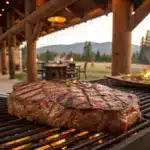
Cowboy Ribeye Steak
Ingredients
For the Cowboy Steak
- 1 piece Cowboy ribeye steak, bone-in At least 2 inches thick
- 0.5 cup Unsalted butter For cowboy butter enhancement
- 2 tbsp Fresh parsley, chopped
- 2 cloves Garlic, minced
- 1 tbsp Lemon juice
- 1 tsp Dijon mustard
For Seasoning
- 2 tbsp Coarse kosher salt For seasoning the steak
- 1 tbsp Freshly ground black pepper
- 1 tsp Garlic powder
- 1 tsp Smoked paprika
- 1 tsp Dried oregano
Instructions
Preparation
- Remove the cowboy steak from the refrigerator and let it sit at room temperature for 30 minutes before cooking.
- Season the steak with coarse kosher salt, freshly ground black pepper, garlic powder, smoked paprika, and dried oregano. For best results, salt 40 minutes before cooking.
- In a bowl, mix the unsalted butter, chopped parsley, minced garlic, lemon juice, and Dijon mustard to create cowboy butter. Chill until ready to use.
Cooking
- Preheat your grill to a high heat (450-500°F) for searing the steak.
- Sear the steak for 2-3 minutes on each side over direct heat until a golden-brown crust forms.
- Move the steak to indirect heat and continue cooking until it reaches your desired internal temperature, about 5-6 minutes longer for a 2-inch thick steak.
- Remove the steak from the heat, and let it rest for 5-10 minutes to allow the juices to redistribute.
Serving
- Slice the steak and serve with a dollop of cowboy butter on top.
